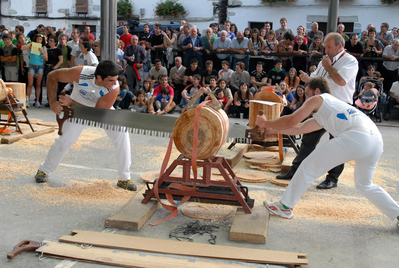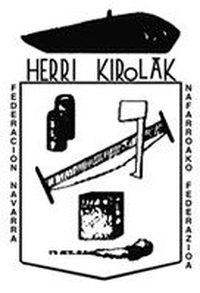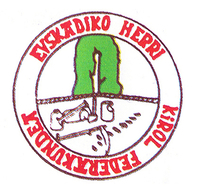
Herri Kirolak (Basque Country)
- Name of sport (game): Herri Kirolak
- Name in native language: Herri Kirolak (in Basque language), Deportes Rurales (in spanish language), Force Basque (in french language)
- Place of practice (continent, state, nation):
Historical land called Baskonia consists of four Spanish provinces (Bizkaia, Gipuzkoa, Alava, Navarra) and three French (Labourd, Soule, Lower Navarra). A large proportion of the inhabitants of these areas speak Basque and consider themselves as a Basque.

Source: By Eddo - Own work, CC BY-SA 3.0, https://commons.wikimedia.org/w/index.php?curid=11102525 - History:
To understand the essence of these sports we have to delve into the history of the Basques - a mysterious people without their own state, living on the border between France and Spain. The feature that distinguishes them from the French and Spaniards is their unique language. It is well known that all the languages come from somewhere. Most European languages belong to the Indo-European family because of their mutual similarity. In contrast, the Basque language scientists are not able to count to the Indo-European family, but also to any family at all. This means that it is not known to current days where the Basques came from and how long they have lived in their areas.
We can guess, however, that they are a very hermetic group since this unusual language has survived among them. In addition to the language, they also kept their customs and sports that they had played for centuries.Basque origin
The most popular theory about the Basque origin assumes that they are the heirs of the first people who displaced the Neanderthals from those lands about 30,000 years ago. This theory is supported by archaeological finds (Santimamiñe cave).
Another theory suggests that they come from nomadic peoples settled in Iberia about 6,000 years ago.
Finally, there is a hypothesis based on the study of grammatical and phonetic features. It suggests the similarity between Basque and Georgian. This could mean that the Basques came to Spain from the Caucasus. But genetic testing showed no similarity between these ethnic groups, so it is assumed that the similarity is accidental.History of Basque
Despite being besieged by countless powerhouses over the centuries, the Basques retained their culture, Rural Sports is one of their cultural element.
The Romans took over the Basque region in the first century BC. Fortunately for the Basques, their area belonged to a deep province at that time. For this reason, it has not been romanized unlike most of Western Europe. Perhaps only because their unique culture has survived, which resulted in the creation of Rural Sports. The greatest trace that the Romans left in Basque was the city founded by Pompeius in the first century BC. - Pamplona. In the 5th century, CE Basques broke free from Roman captivity. They had to defend themselves against attacks by the Franks and Visigoths, and from the eighth century, also by Muslims who reached north of Spain. Finally, the Basque country was conquered by the Franks.
After the Franks regime in the eighth century, another independent Basque state arose, founded in 824. At first, it was called the Pamplona Kingdom, it evolved into the Kingdom of Navarre. It was not an international country, but its existence meant independence for the Basques. Traditions and culture have developed.
After the rebound of Spain by Christians (a trial that lasted from the 7th to the 15th centuries), a new threat to Basque independence arose - the Kingdom of Castile. It took over the southern part of Navarre in 1512. The northern part was annexed to France in 1589. Historically, the Basques enjoyed wide autonomy, which was granted to them by fueros - privileges. Thanks to them, they had their own courts and taxes as well as the traditional legal code. Autonomy allowed their culture and sports to develop.
The Basques of the Middle Ages were considered the best fishermen in the world. They were the first to come up with the concept of commercial whaling - they dealt with it in the 7th century CE. They were the first to venture deep into the Atlantic, fished off the coast of Iceland, and were also pioneers when it comes to fishing on the American coast. Basque’s sailing skills are demonstrated by the story of Juan Sebastián Elcano. He was a participant in the Magellan’s expedition to circumnavigate the world. When Magellan was killed in the Philippines, Elcano, a Basque sailor, took command. He led the expedition to the end in 1522. These rich sailing traditions influenced the shape of village games (see Plucking goose heads [Antzar eguna] and Regatta on trainers [Estropadak]).
While the Spanish Basques enjoyed autonomy (fueros were supported by conservative nobility), in France after the revolution of 1789-1799 centralization and removal of privileges took place. Iron factories were built during industrialization in Baskonia. Suddenly, after years of Basque emigration to richer regions, Baskonia became the destination of immigration for people from the poorer parts of Spain.
During the civil war in Spain in 1936–1949 Navarra suffered greatly. An example would be the bombing of the Basque city - Guernica, as a result of which about 70% of the city's buildings were destroyed. During the rule of General Franco, the Basques were subjected to repression. As a result, a Basque nationalist terrorist organization - ETA was formed. Fortunately, despite the years of terror, the Basques maintained their cultural separateness, and Country Sports were still practiced.
Since the introduction of democracy into the country in 1975, Baskonia has enjoyed autonomy - it has its own parliament, education system, etc. The Basque authorities have been trying to disseminate Basque Sports. Despite this, many Basques are not satisfied with its scope, there are separatist movements. - Description:
Nature of sports
The Basques had been doing physical work for centuries - they were fishermen, farmers, shepherds. Basque country games reflect their daily lives. They are aimed at improving those skills that were necessary to perform their professions. Just look at the names of individual sports to guess what profession they are associated with. Here are some examples:
Sport Related profession
Aizkolaritza (cutting the logs) - woodman
Harrijasotzaileak (stone lifting) - miner, builder
Ingude altxatzea (lifting the anvil in shortest possible time) - smith
The nature of these sports also results from the Basque disposition, they like competition. Farmers used to bet on which one is stronger. The competition to settle the bet was the highlight of the day, taking place on squares in city centers.
H18K
In 2006, Basque autonomy distinguished 18 rural sports. These are not all sports, but the most popular ones. This list is called H18K. It contains the following sports:1 – Stone lifting (Harrijasotzaileak)
Probably the most popular of all rural sports. Stone can weigh from 100 to over 300 kg. The stones can have the form of a cube, sphere, cylinder or cuboid. Modern forms also have recesses used as handles.
2 – Lifting the anvil in shortest possible time (Ingude altxatzea)
The sport about raising the anvil, hitting it against the structure above the player's head and placing it on the ground. The player who repeats this action the most times within the specified time wins.3 – Cutting the logs (Aizkolaritza)
Competitors must cut the trunk on which they stand as soon as possible with an axe. This sport is popular, often shown in the Basque cities centers during festivals.4 – Sawing (Trontza)
The trunk is placed horizontally on stands. Two competitors use a 2-meter-long hand saw. The goal is to cut the trunk into rings a few centimeters thick. In another variant, the trunk is upright.
5, 6, 7, 8 - Giza-abere probak (literally animal-human tests)
It is about moving heavy stones on the ground. The goal is to move them as far as possible.
5 - Giza probak - a stone weighing up to 750 kg is attached to a man.
6 - Zaldi probak - the stone is attached to the horse.
7 - Idi probak - the stone is attached to an ox.
8- Asto probak - the stone is attached to a donkey.9 – Drilling holes in the rock (Harri zulaketa)
Sport derived from mining traditions in the region. Two teams of three players participate in the game. With the help of a long metal headband (laztabin) they try to drill through the stone on which they stand. One player drills, the other pours water on the hole, and the third rests, every now and then a change occurs. The team that finishes work first wins.10 –Pulling up a hay bale(Lasto altxatzea)
It involves pulling a hay bale using a high tripod with a rope pulley, through which the rope passes. One end is attached to the ballast and the other is held by the competitor. Bales weigh 45 kg in the case of men's competition and 30kg in the women's category. Within 2 minutes, raise and lower the bale as many times as possible.
11 – Hay bale throw (Lasto botatzea)
The competitor must use the forks to flip through the bale of hay over the crossbar. For men, it is set at a height of 7 meters, for women - 5 m.12 – Collecting corn cobs (Lokotx biltzea)
Each player has his own track. On its length (about 30 meters) are arranged in one meter intervals corn maize. At the beginning of the track, each player has their own basket. When the start password is given, the players rush to the last butt of their track. They pick it up and then run towards the basket. When they are nearby, they put the flask into the basket (you can also throw to save time). This process is repeated until the player collects all the butts. This sport requires high endurance because one game lasts about 9-10 minutes. Currently, the flasks are replaced with pieces of boards.13 – Wearing a milk churn (Ontzi eramatea)
The player carries a milk churn in each hand and must go as far as possible without stopping. He usually walks on the running track. This is a test of strength and endurance because each churn weighs about 40 kg. There are also forms for children, in which instead of a churn a piece of wood is used. Another variation on this sport is transforming it into a team game in the form of a relay, where the churns are passed to the next competitor after taking a lap.14 - Weights carrying (Txinga eramatea)
Similar to wearing a milk churn. Competitors carry weights up to 100 kg in both hands. The goal is to walk with them as far as possible. The best athletes are able to cross 500 m.15 – Lifting the cart (Orga jokoa)
A show of strength. One person acts as a ballast, standing on the part of the cart where the horse's harness is attached. The competitor stands at the other end of the cart, lifts him and walks with him in a circle whose center is ballasting.
16 – Haymaking (Sega jokoa)
It has several variants, all are based on competition. In one of them, two players have an hour to mow, using a scythe, as much grass as possible. Some competitions may last for two hours. Alternatively, both players get an equal size of the field and the first to finish wins. Masters of this discipline are able to mow up to 4 tons of grass, which corresponds to 5000m2.
17 – Rope pulling (Sokatira)
Two teams of 8 are fighting with each other. There are weight categories. The rope should be less than 32 meters long. The lines are marked:
- midpoint (red color)
- at a distance of 2 m on each side of the red p. - white points
- 5 m. from white points - blue points
In addition, the center line is marked on the ground and, parallel to it, on a line on both sides, at a distance of 2 m. The goal is to drag the enemy's blue point above your line. This means that you need to stretch about 9 m to win.18 –Racing with sacks (Zaku eramatea or „smugglers run”)
A relay race in which 3-person teams participate. The competitor runs with a sack weighing about 75 kg. on the back. The ballast is generally beans.
Other popular Rural Sports
1 – Ripping off the goose head (Antzar Eguna)
One of the most unusual Rural Sports, which, unlike other disciplines, comes from the Basque traditions of sailors. It is pursuing during the Fiesta de San Antolín in the seaside town of Lekeitio. A several meters high pole is set up on the waterfront. Parallel to the quay, a fishing boat is anchored at a distance of several meters. An elastic rope is set between the top of the pole and the mast of the cutter, the ends of which hang down to the ground so that it can be pulled or loosened on both sides. A whipped goose is attached to the middle of the rope. This is done in such a way that her neck hangs within reach of the person standing in the boat. A rowing boat carrying a competitor is sailing under the goose. The competitor grabs the goose by the neck. His task is to rip her head off before she falls into the water without the head. It may seem very simple, but the rope is operated from both sides by several men. As a result of its loosening and tensioning, the competitor together with the goose can, under a second from 15 meters above the water, go underwater (and vice versa). If the athlete manages to tear off the goose's head, the rest wins.
2 – Regatta on trainers (Estropadak)
It is not a sport directly belonging to the Basque - it is practiced by the inhabitants of the Bay of Biscay, including the Basques. Boats called trainer are used. These are rowing boats 12 meters long, with 13 rowers and a helmsman. Historically, they were used to fish for sardines, but over time regattas began to be organized. In the past they were made entirely of wood, nowadays plastic is used. The first regatta was organized in the city of Santander in Spain in 1859. The Basques did not remain indebted to the Spaniards and began to organize their own regatta from 1871. Currently, the most popular race takes place in Baskonia under the name Kontxako Estropadak since 1879. - Current status:
Basque Rural Sports are practiced all over Basque, both by old and young. Their popularity is associated with shows during holidays and festivals, and with government policy.
Rural sports can be seen at many festivals and games in the Basque cities, for example:
-Festival in Bilbao (Aste Nagusia) - games related to the week before the feast of the Assumption of the Virgin Mary are accompanied by Basque sports shows.
-Festival in Vitoria-Gasteiz (Virgin Blanca) - Playless in the city from 4 to 9 August, graced by shows of rural sports.Champions:
- Bittor Zabala, called Arteondo - master of stone lifting, active in 1910-1945. He can be called a reformer of this sport. In the past, each player could use stones found in nature. Arteondo created a taxonomy in which boulders had to be of a given weight and have the shape of a ball, cylinder, cube or cuboid. Thanks to him, Harrijasotzaileak has become a sport, not just a rural game. In the picture, we can see a monument erected for him by the Basques.- Iñaki Perurena - Champion of Harrijasotzaileak, lifting stones. He set a record, being the first Basque to lift a stone heavier than 300 kg. He contributed to making this sport famous throughout Spain. He is currently 52 years old.
- Pedro Mendizabal and Jose Arrieta - The most famous grass mowers (Sega jokoa). In 1925 they played a game watched by 6,000 spectators. Apparently, the bets that day were worth 150,000 Spanish pesetas (at least 300,000 modern euros).

- Importance (for practitioners, communities etc.):
Basque rural sports are an important Basque cultural heritage. The creation of the H18K list shows how much they care about maintaining this tradition. Unfortunately, these sports are not popular enough to be maintained. Even the best athletes must work full time and train after hours.
- Contacts:
Federación Navarra de Herri Kirolak
Gindal Ibiltokia, 1 bajo
31791 Sunbilla
Tel.: 948 450900
MÓVIL: 622368428
E-MAIL:This email address is being protected from spambots. You need JavaScript enabled to view it.
webside: http://herrikirolaknafarroa.org/
Euskadiko Herri Kirol Federazioa
“Casa Auditorio de Astola”
48220 ABADIANO (VIZCAYA)
tel. 94 681 81 12
e-mail:This email address is being protected from spambots. You need JavaScript enabled to view it. 
Bizkaiko Herri Kirol Federakundea
Martin Barua Picaza nº 27, 3º. 48003 Bilbao
Tel. 94 421 77 81
Fax 94 421 63 21
e-mail:This email address is being protected from spambots. You need JavaScript enabled to view it.
webside: http://herrikirolakbizkaia.eus/
Fb: https://www.facebook.com/herrikirolak/
- Sources of information :
Books:
Iñaki Mendizabal Elordi Kepa Lizarraga Sainz José Manuel Fuentes Mateos, Guía para la enseñanza de Herri-kirolak, Servicio Central de Publicaciones del Gobierno Vasco, Vitoria-Gasteiz, 2009Articles:
http://www.sehacecaminoalandar.com/deportes-rurales-vascos-herri-kirolak-h18k/Films:
https://www.youtube.com/watch?v=vck32S27RmM
https://www.youtube.com/watch?v=AsdKxbXsP3k
https://www.youtube.com/watch?v=bMehJ72Nzok
https://www.youtube.com/watch?v=u_MxWJindhI
https://www.youtube.com/watch?v=yQtFGZSNC5g - Gallery:
- Documents:

